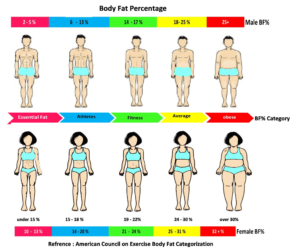Is my body shape an hourglass, a triangle, or even a rectangle? If you’re troubled by this dilemma, we have a solution for you: a reliable body type calculator that gives you a clear answer in just a few seconds. Rather than scrutinizing your image in the mirror and guessing which form it most closely resembles, we provide you with a quick and accurate technique to identify your body type. Simply enter your dimensions into the body form calculator and choose one of the seven most common groupings.
Make sure to figure out your desired weight and BMI as well! You may also use our maintenance calorie calculator to figure out how many calories your body needs to keep you at your current weight.
read also: Calorie Calculator
How to take Body Shape measurements
- Bust. Using a delicate measuring tape, measure your bust at its fullest point. Breathe in and out to make sure the tape isn’t too tight.
- Waist. The narrowest area of your torso is your waist. The measuring tape you bring around your waist should sit snugly against your skin but not “dig” into it. Also, don’t pull your stomach in.
- Hips. The broadest spot below your waist is where you measure your hips. Remember to take off your clothes and keep your feet together for the most accurate measurement.
- Hips that are high. This is another hip measurement, but this one is taken at a different location from the last one. It’s taken from the top of the hip curve, not the broadest part.
read also: Harris-Benedict Calculator (Total Daily Energy Expenditure)
What is my body type?
Our body shape calculator will assign one of the seven most common body types to you. Naturally, not every woman who falls into one of these categories is the same.
- Hourglass. This body type is harmonious and balanced. The waist is strongly defined, and the breast and hips are proportionate and well-balanced.
- Hourglass at the top. It has a waist that is finely defined, comparable to a conventional hourglass. Your breast appears to be bigger than your hips.
- Hourglass at the bottom. This body shape, like the upper hourglass, has a well-defined waist. The size of your chest is smaller than the size of your hips.
- Spoon. Your hips are substantially bigger than your breast if you’re a spoon. Your hips have a shelfy aspect, and your waist is well defined.
- Triangle. The upper body of a triangle is slender, but the hips are broad (typically wider than the shoulders). Their waistline isn’t really defined.
- inverted Triangle. A modest waist and a correspondingly broader upper body characterize inverted triangles. Your breast, shoulders, and hips are all very wide, yet your hips are narrow.
- Rectangle. Your hips, waist, and breast are all approximately the same size, which is referred to as a “boyish” body type. Your body appears to be well-balanced and athletic.
Now that you’ve figured out what body type you are, you may put your newfound knowledge to good use. Making educated decisions while dressing or buying clothes will undoubtedly help you feel more confident and attractive!
read also: Waist to Hip Ratio Calculator
FAQ
What is the most common body shape?
A rectangle is the most frequent body shape, accounting for 46% of women. A lady who has a waist that is less than nine inches smaller than her hips or bust is described as a rectangle. The bottom-heavy spoons,’ who have hips that are two or more inches bigger than their busts, come next. These women make up around a quarter of the female population.
The inverted triangles, which make up around 14% of the population, are the third group. Women whose busts are three inches or bigger than their hips fall into this category. Finally, there are the hourglasses, women with a slimmer waist and about equal hip and bust measurements. These ladies make up around 8% of the population.
Does a woman’s body shape change with age?
Yes, the concentrations of hormones in a woman’s body shift as she matures, causing her body form to change. Puberty brings about the first changes. The hip-waist ratio of prepubescent boys and girls is identical, but the huge levels of estrogen generated at puberty lead a female’s hips to broaden and breasts to grow.
Fat is also accumulated in the buttocks, thighs, and hips as a result of estrogen. Estrogen levels rise during pregnancy, leading the breasts to expand, however, this is usually corrected after the pregnancy. Reduced estrogen levels cause a woman’s breasts to shrink, as well as fat redistribution to the waist or belly, as she enters menopause.
Can you change your body shape?
After puberty, it’s very hard to modify your body form because your bone structure and proportions are mostly set. However, there are certain adjustments that may be done. If you’re a premenopausal woman, fat gain or loss will affect the size of your buttocks, thighs, and hips; if you’re a male or a postmenopausal woman, fat gain or loss will affect the size of your waist and abdomen.
Gaining muscular mass is another technique to change your shape; by focusing on certain muscle parts, you may highlight them, such as your shoulders to make them look more athletic, or your hamstrings and glutes to make your legs appear longer.
What is a healthy waist size?
A healthy waist size varies by height, but if your waist measures more than 31.5 inches (80 cm) for a woman or 37 inches (94 cm) for a man, you should aim to reduce weight, regardless of height or BMI. Between the hips and the ribs, the waist is the thinnest region of the body. Obesity is defined as a waist circumference more than 40 inches (102 cm) for males and 35 inches (88 cm) for women, according to the World Health Organization.
A waist-hip ratio of more than 0.9 for males and 0.85 for females is likewise considered obese. You may use our waist-hip ratio calculator to find out what yours is. Obese people have a higher chance of developing diabetes.
Does your body shape change when you lose weight?
When you lose weight, your body form does alter. Because of the estrogen in your body, your body will naturally retain weight on your buttocks, thighs, and hips if you are a woman. These places will grow thinner as you lose weight.
Your body will retain fat on your stomach if you are a man. You may get rid of your beer belly by losing weight.



